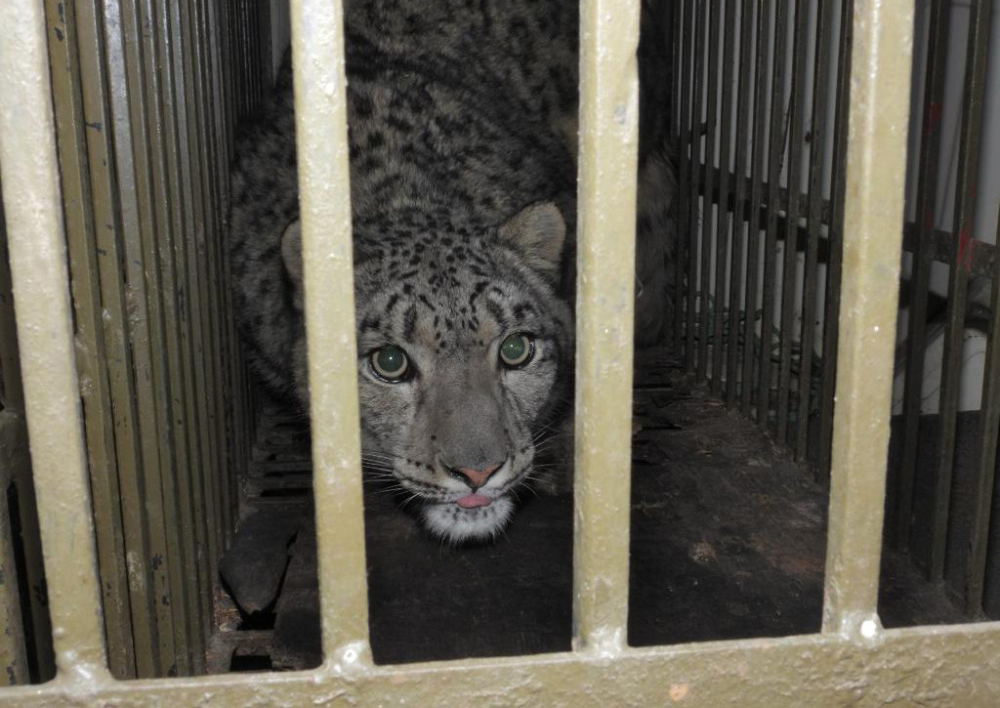 The Nepal Weekly
The Nepal Weekly  January 30, 2024
January 30, 2024
A news has been spread across the country that a baby leopard has been sighted in densely populated area of Morang district. The wild animal has been trapped in Urlabari Municipality of Morang district. The locals informed about this to the District Police and District Forest Office. As both the offices could not deal with the situation, then this incident was reported to the National Trust for Nature Conservation. A team of conservation staff then arrived at the incident site and darted the leopard to rescue it safely. Later the animal has been identified as a snow leopard.
As the NTNC and other offices do not possess a cage equipped with air conditioner the leopard has been shifted to the Central Zoo for a safe shelter.
Normally, snow leopards dwell in the Himalayan mountains but finding it in the Terai at 150 m from the sea level raised questions in the minds of experts. The temperature at that time was 14o Celsius. Moreover, snow leopards prefer to stay away from human settlements and they are rarely sighted in the wild. Thus, they are also known as ‘ghosts of mountain.’
The reason why it was found in the warm climate has been a matter of investigation for experts. Experts also suspected that the construction of roads and other structures have disturbed their habitat. Shortage of food in the wild might be one of the reason for the animal to go to Terai region, point out experts.
The authorities had informed that the creature will be sent to natural setting where snow leopard are normally dwell.
Moreover, snow leopard (Panthera unicia) is known as the apex predator of the Himalayan ecosystem and are found in the high mountains of the Central and South Asia. In Nepal, potential snow leopard habitat is estimated to be about 13,000 km2, with a large number of snow leopards found to be occurring outside protected areas. The Government of Nepal has adopted landscape conservation planning approach to conserve the snow leopards by delineating three large conservation landscapes – the eastern, central and western landscapes. Nepal of is one of the 12 snow leopard range countries and the current estimated global snow leopard population range from 3,921 to 6,290, with Nepal having an estimated 350-500 snow leopards. Although their intentional killing is virtually absent among the local people, snow leopards have become victims of retaliatory killing. Snow leopard’s main prey species (blue sheep and Himalayan tahr) are depleting in numbers because of overgrazing of rangelands from domestic livestock, along with shifting traditional herding practices and overexploitation of medicinal plants. The shortage of natural prey lead to conflict with humans when snow leopard prey on livestock. Snow leopards live above 3,500 m in the rugged mountain terrain rendering their monitoring and detecting their poaching extremely difficult. ‘Compressing’ snow leopard habitat could be further compounded by more intense habitat overlap between livestock and prey species, and with sympatric species such as common leopard, Himalayan wolf.
Listed in CITES Appendix I and protected under the National Parks and Wildlife Conservation Act, 1973, snow leopards were classified as ‘Endangered’ in the IUCN’s Red List and down-listed in 2017 as Vulnerable because of the recent increase in their global population attributed to better population estimate using more reliable survey methods.
The Snow Leopard Conservation Action Plan of Nepal targets to ‘maintain a viable population of 100 breeding age snow leopard population with a support of adequate prey populations, and have functional connectivity to other snow leopard landscapes, some of which are sharing international boundaries and are conserved with the local community participation’. Due to their extensive home range and the need for overall biodiversity conservation in the landscapes, managing snow leopard population as meta-populations for their long-term conservation is in the priority.
To ensure long term human-snow leopard co-existence, herder communities are supported with predator-proof corals and non-lethal predator deterrents that have been of tremendous help to the herders, retaining their positive sentiments to snow leopards. In addressing livelihood loss to livestock predation, NTNC has initiated community livestock insurance schemes that provide relief to victim herders, securing snow leopards from retaliatory killing. In the days ahead, NTNC will continue to lead snow leopard conservation by engaging its technical expertise and enabling local communities in snow leopard monitoring and research, developing better ways to mitigate human-snow leopard conflicts, generate community awareness, and initiate snow leopard focused activities in other snow leopard landscapes. (By Ram Dangol)

